The path forward
From the micro to the macro, the new Institute for Environmental Sustainability has the planet covered
Features
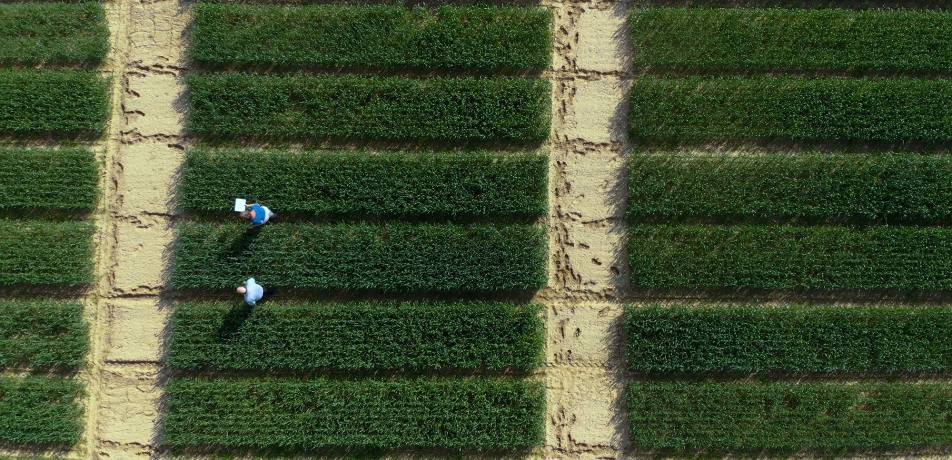
A beautiful meadow near the Weizmann Institute campus in Rehovot, is the place where Prof. Ron Milo goes to think, relax, and draw inspiration. He wonders, “Will my daughters be able to enjoy this meadow in the same way? Will we all be able to enjoy all that nature provides in 10 years?”
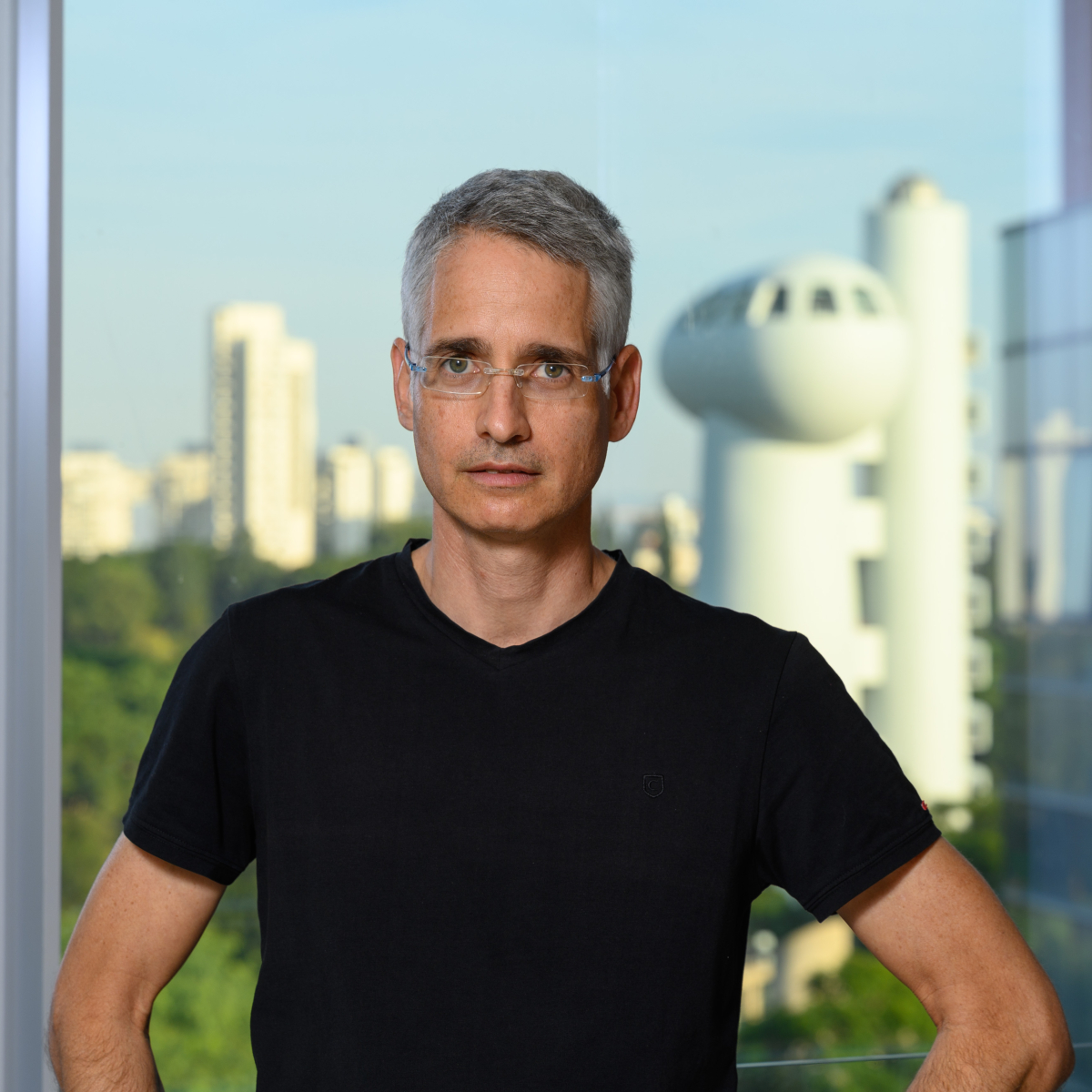
Prof. Ron Milo
Prof. Milo is not alone. People from every corner of the globe and all walks of life—scientists, economists, business leaders, policymakers, activists, and artists— are sounding the alarm. Marked by rising temperatures, melting glaciers, widespread pollution, and desertification, the escalating environmental crisis affects every aspect of modern civilization, and saving our planet requires urgent, bold, and collective action.
Weizmann researchers are looking to science to find a way to overcome these challenges. “At the IES, we use curiosity-driven research as the path that will take us toward a healthy and prosperous future while preserving and protecting theplanet,” Prof. Milo says.
With a 10-year timeline, the Weizmann Institute launched its newest flagship last year—the Institute for Environmental Sustainability (IES). The goal: to create a more sustainable future through science. Building on decades of pioneering studies in environmental and alternative energy science, the IES represents the Weizmann Institute’s fullfledged commitment to research that will protect our planet for generations to come.
Comprised of seven research centers and three over-arching initiatives, the IES will direct significant resources to cutting-edge sustainability science and provide investigators with the best platform to address the most pressing environmental problems. The scientific steering committee—Prof. Yinon Rudich, Dean of Chemistry, Prof. Avi Levy, former Dean of Biochemistry, and Prof. Milo, Dean of Education and Director of the IES—reflects the flagship’s multidisciplinary character, led by some of the foremost scientists in their fields. The IES will also make use of Yeda Research and Development, Weizmann’s tech-transfer arm, to get scientific breakthroughs into the hands of innovative startups and industry leaders who can use these discoveries to develop adoptable, earth-saving technologies.
“It is our responsibility as an institute to fulfill the potential we have,” says Prof. Roee Ozeri, Vice President for Development and Communications at the Weizmann Institute. “Our potential to make a paradigmatic change in the field of sustainability science has been built over years of interdisciplinary research in SAERI [the Sustainability And Energy Research Initiative]—and other ventures, and has created a solid foundation for a venture of this magnitude.”
Getting to the core
The IES will address the environmental crisis through seven core research areas, and in the Weizmann collaborative spirit, scientists from diverse fields will participate in studies across the different centers. An internal grant program will provide the freedom to pursue new, “out of the box” ideas and collaborations—two hallmarks of Weizmann success.
RENEWABLE ENERGY
To address the urgent need for clean and sustainable energy production, the Center for Renewable Energy will promote collaboration between scientists from multiple faculties—theorists and experimentalists, chemists, physicists, and biologists—to tackle the current gaps in harnessing and storing renewable energy and uncover the scientific basis for the development of clean technologies to power future generations.
BIODIVERSITY AND ECOSYSTEMS
Now exceeding 8 billion people, humankind is having an increasingly harmful impact on our planet. Research from the Weizmann Institute shows that livestock and human beings—not wild animals such as bears, elephants, or whales—now make up the majority of mammals (90% of their biomass) on Earth. The Center for Biodiversity and Ecosystem Research will develop nature-based solutions for biodiversity, measuring the effects of climate change on forest ecology, understanding the genetic resilience of wild wheat populations, and identifying microbial biomarkers for animal and plant biodiversity loss.
MARINE RESEARCH
While data on human impact on the climate is amassing, our picture of our oceans is piecemeal at best. A more holistic understanding of the situation, along with the causes and mechanisms behind the changes, is needed to create a comprehensive picture and devise science-based solutions. The Center for Marine Research will bring together scientists who study marine biology and climate change at all levels—from the effect of rising temperatures on pathogens in the water to the weather and current systems that carry plastics and bacteria from one end of the globe to the other—to produce a detailed map of how climate change is affecting marine ecosystems, and develop the tools to repair them.
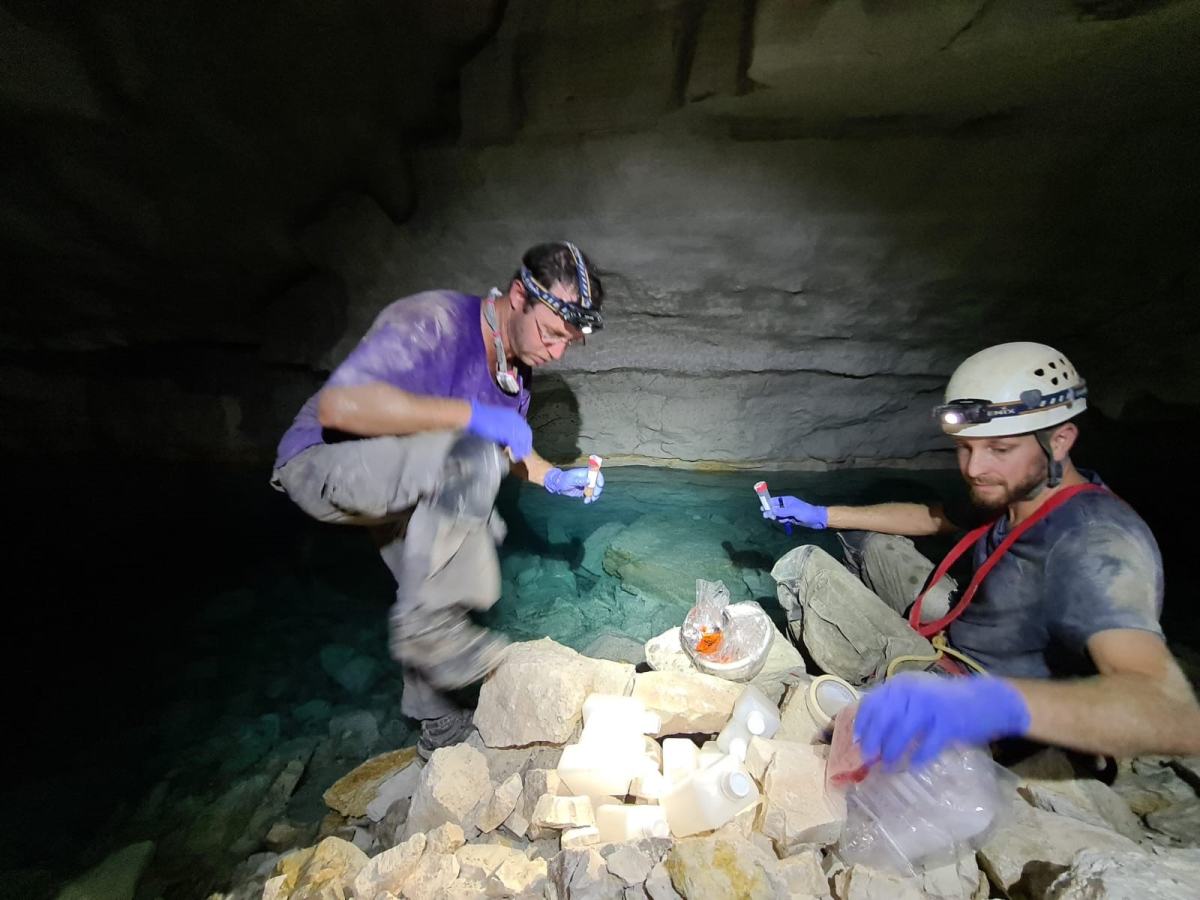
Dr. David Zeevi (right) with Dr. Oren Kolodny from Hebrew University, collecting samples from a cave in central Israel. (Photo courtesy of Marketa Jakoveno)
SUSTAINABLE MATERIALS
Our current reality requires a host of new materials that maintain and improve current quality-of-life standards while minimizing their environmental toll. The Center for Sustainable Materials Research will support the development of new resource-efficient, nontoxic, biodegradable, and carbon-neutral materials and processes—including the preparation of green molecular components, coating treatments, and device fabrication. Their discoveries will support the clean catalytic processes, energy storage, carbon capture and isolation, and the conversion of solar energy into electricity essential for a sustainable future
ENVIRONMENT AND HEALTH
With chronic disease rates steadily increasing across the globe, the Center for Environment and Health Research is dedicated to studying the effects of climate change and environmental degradation on human health. By better understanding the mechanisms by which air and water pollution, airborne pathogens, and a host of other elements cause morbidity and mortality, Weizmann scientists can provide the necessary knowledge for prioritizing mitigation strategies, as well as the means to slow or even reverse current trends.
CLIMATE RESEARCH
Our world is growing hotter by the day, with human activity driving up temperatures at a rate surpassing the changes evident over the past million years. Global warming has led to an increase in extreme weather events with devastating consequences, such as the melting of the polar ice caps, desertification, and the loss of biodiversity. At the Center for Climate Research, scientists will investigate emerging phenomena and predict future patterns using state-of-the-art observational technology and advanced models, to better understand and forecast climate trends, as well as develop mitigation and adaptation practices.
FOOD SECURITY AND NUTRITION
Extreme weather events, water scarcity, and land degradation, combined with population growth, urbanization, pollution, and the emergence of new diseases, have made providing nutritious food to every person on the planet one of the most pressing challenges of the 21st century. Investigators at the Center for Food Security and Nutrition Research will apply their expertise in genomics, computational biology, genome editing, microbiology, protein design, and other disciplines to develop a new generation of nutritious crops that are adapted to a changing climate and can be grown in a sustainable fashion.
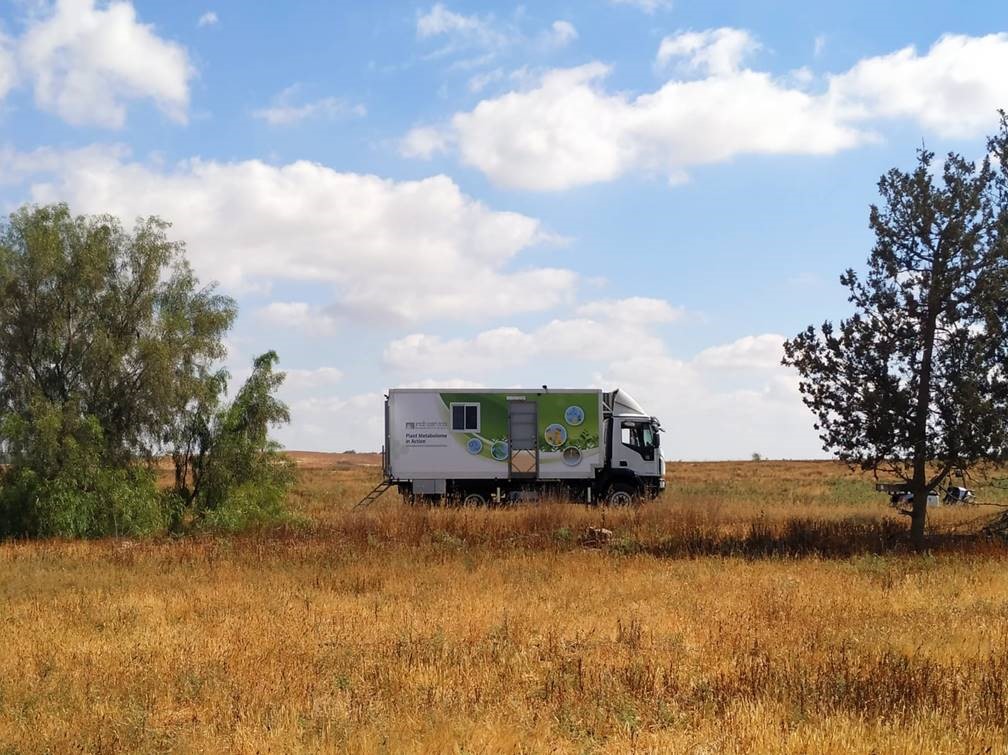
Prof. Asaph Aharoni’s Mobile Lab for Plant Science Research. (Photo from the Aharoni lab)
Educate, collaborate, go green
The IES has created three pillar initiatives to enhance the impact of the innovative research happening under its virtual roof. These comprehensive programs aim to empower the next generation of scientists, foster collaborations, and make the campus truly green.
The educational ecosystem
The flagship’s education-focused initiative expands upon the SAERI fellowship program, established in 2018, encouraging young researchers to pursue sustainability science and offering mentoring to outstanding students. Now, annual cohorts of IES Fellows will participate in the most advanced environmental research and interdisciplinary events. To create a supportive educational ecosystem, IES Fellows and faculty will also engage schoolchildren through sustainability programs at the Davidson Institute of Science Education, Weizmann’s science literacy arm, and schoolteachers through professional development activities at the Department of Science Teaching. Finally, science communication training will prepare students and faculty to effectively convey their findings to the public and policymakers, and fund a center for effective science communication.
Global and local partnerships
The Weizmann Institute’s existing collaborations with world-leading research institutions, public agencies, and industry provide an important base for the timely deployment of basic science to address the environmental crisis. The IES will build upon these extensive networks to broaden local, regional, and international partnerships that can impact technology transfer and the implementation of effective solutions.
Going green
Through its Green Campus initiative the Institute aims to “walk the walk” by incorporating the latest breakthroughs in sustainable built environments, including energy-efficient materials, water conservation and recycling, and biodiversity protection. The resulting green-campus model will promote environmental responsibility, provide a healthier setting for students and staff, and serve as an educational platform to raise awareness and share best practices.
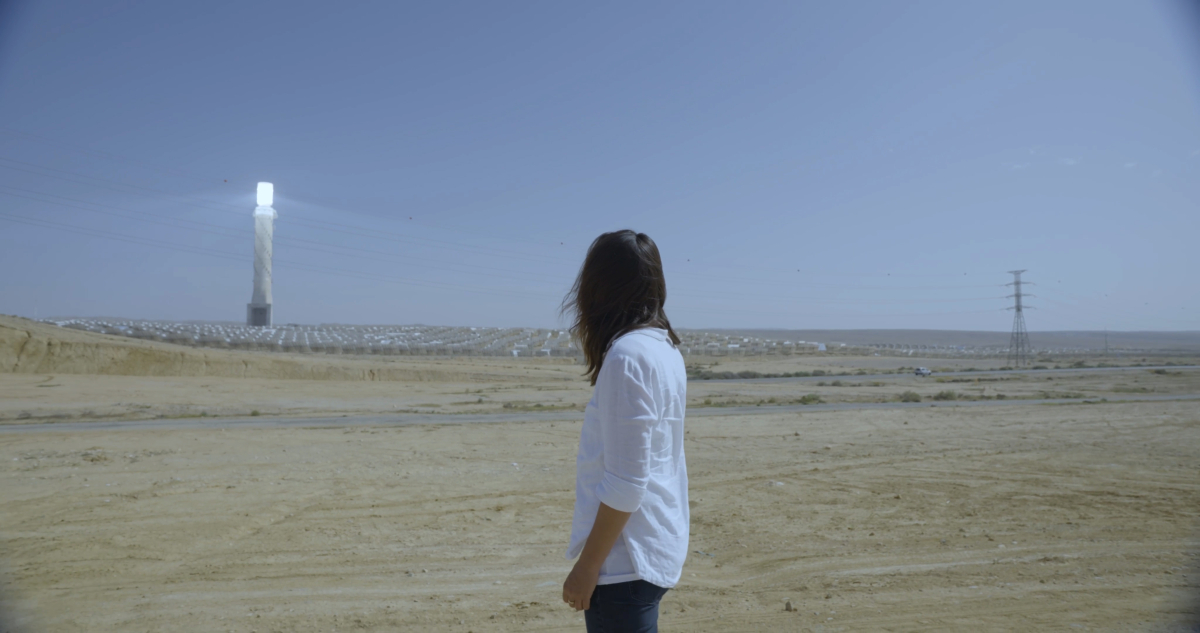
Dr. Sivan Refaely-Abramson in front of the Ashalim solar power station in Israel’s Negev Desert.
Something in the atmosphere
Dr. Shira Raveh-Rubin, Department of Earth and Planetary Sciences A vision for brighter days
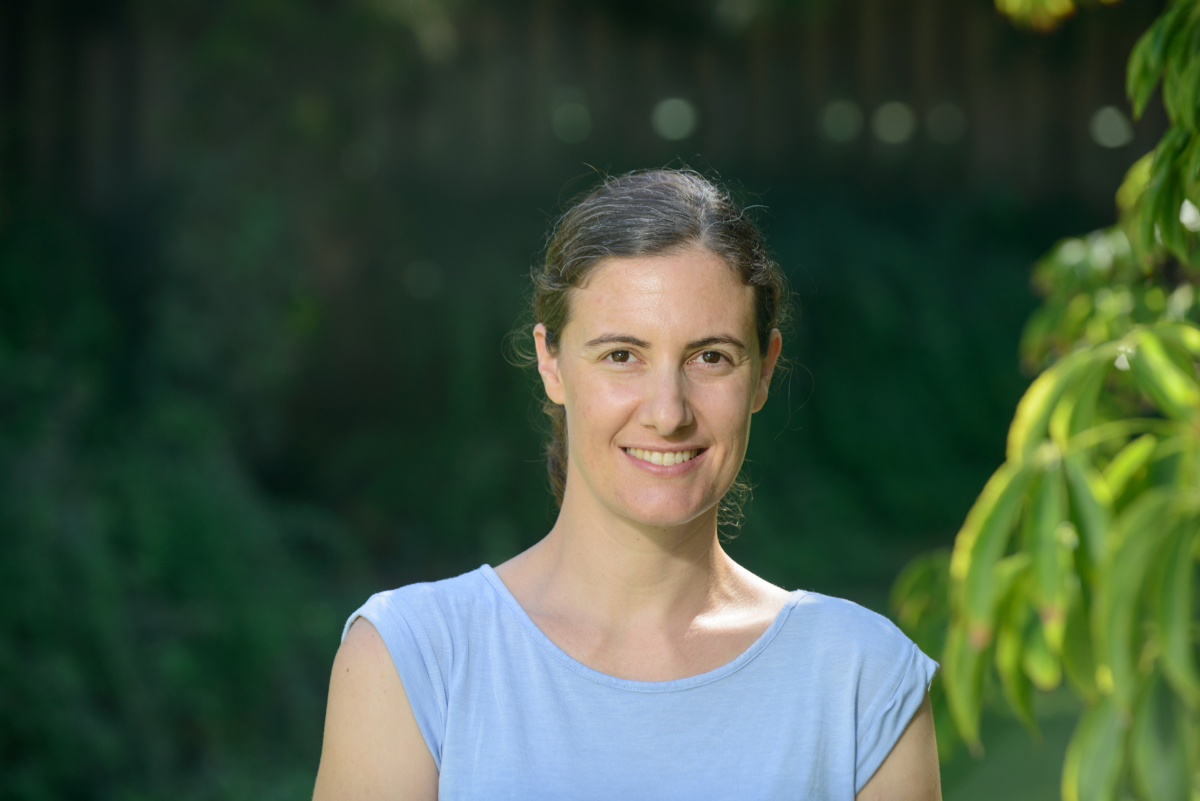
A lover of all things science, Dr. Shira Raveh-Rubin considers herself lucky to have found her field of study. In high school, she took courses in math, physics, Earth sciences, and even philosophy. Eventually, she fell in love with atmospheric sciences. The perfect combination of two disciplines close to her heart—the natural environment and physics—atmospheric science combines theoretical knowledge (physics) with complex reality (weather).
Her research has also given her the opportunity to travel around the world and observe the many ways that weather manifests itself.
“When I visit different regions, I walk around observing the sky and I see that clouds are not the same and storms are not the same. My work is about gaining a deep understanding of what is causing these differences and the kind of impact that these storms could have,” she explains.
By combining case studies of highly destructive storms with the analysis of detailed and long-term weather and climate data, Dr. Raveh-Rubin hopes to improve both weather forecasting and global climate modeling.
She doesn’t have to travel far to access one of the greatest weather labs on Earth. With thousands of years of human activity surrounding it, the Mediterranean region is a crucible for the study of climate change. Extreme weather—including heavy precipitation and flash floods in the fall; strong winds and waves in the winter; and heat waves, droughts, and forest fires in the summer—regularly cause heavy damage in the Mediterranean.
The applicability of her efforts does not escape her. “Humanity feels climate change through weather extremes,” says Dr. Raveh-Rubin. A better understanding of the complex weather processes can allow better weather forecasts and climate predictions and that, she says, “is key to the way forward.”
Measuring the ebbs and flows
Dr. Yael Kiro, Department of Earth and Planetary Sciences
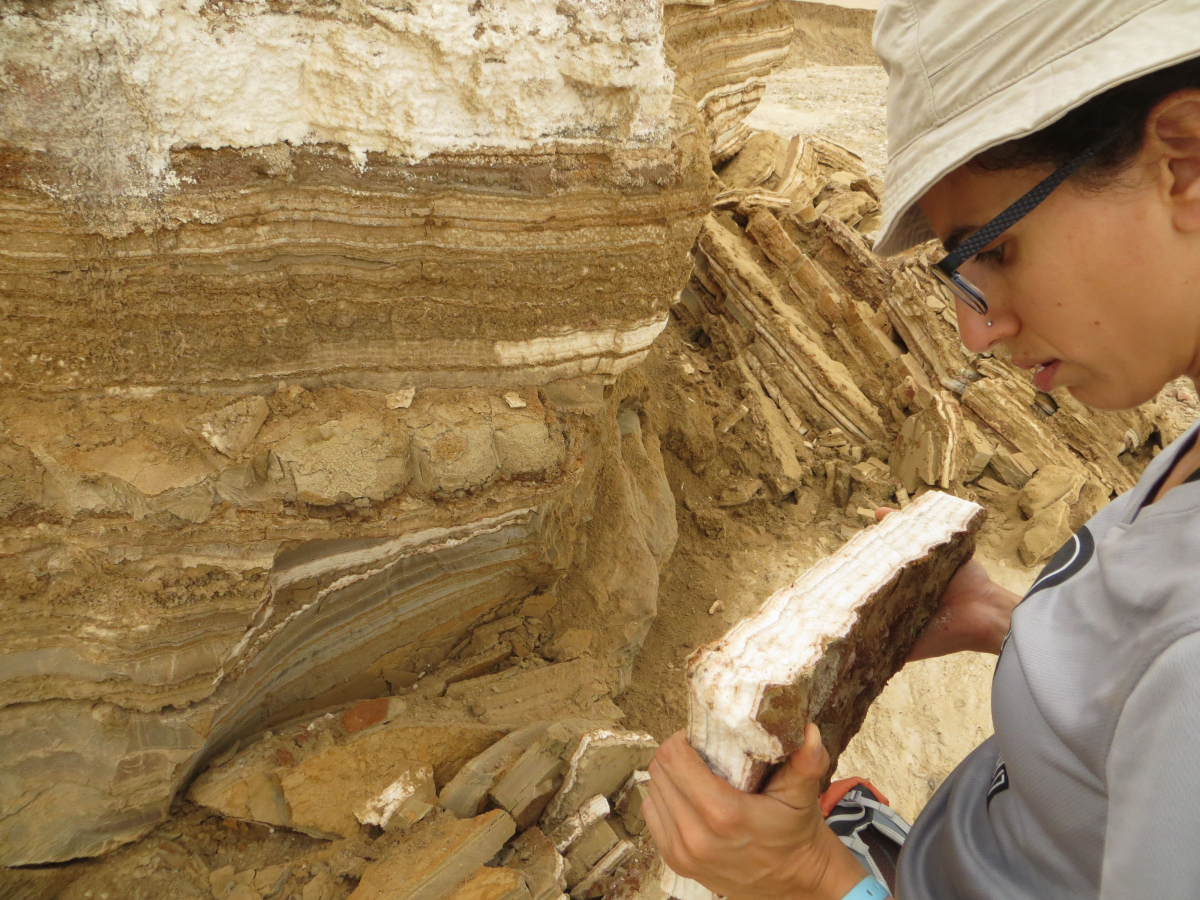
Dr. Yael Kiro at the Dead Sea, examining a salt layer formed during a dry period several thousand years ago. (Photo from the Kiro lab)
Since she was a child, Dr. Yael Kiro says she has always felt connected to nature. “It is a fundamental part of my being. When I am outside in nature, I feel very calm. It drives my creativity and I get so many ideas,” she says.
At first, she was interested in space and dinosaurs, and often dreamt about being an astronaut. In school, she was attracted to physics and computer science because she was good at math, and during her military service, she taught kids about the environment through the Society for the Protection of Nature in Israel. So it was no surprise to her family and friends when she decided to become a geologist.
Since then, she has studied all kinds of waterways and flows—from measuring the movements of carbon and other minerals between coastal aquifers and the sea to understand their contribution to the ocean’s carbon budget, to tracking the declining water levels and historical climate clues in the Dead Sea—with the environment always on her mind. When asked how she keeps going after witnessing so many years of environmental decline, Dr. Kiro maintains she is optimistic: “There are still 250 meters of water in the Dead Sea. There is still time to figure out what to do.”
Perhaps it is this same optimism and personal connection that have spurred her to use her expertise to advance environmental policy. She has served as an advisor to the government and consulted for NGOs on Dead Sea preservation and rehabilitation.
As part of the IES, Dr. Kiro is developing models to predict the ocean’s ability to take in and regulate carbon under various scenarios, testing the effect of changing sea-levels on the ocean’s carbon cycle over time. Her research is essential for understanding the causes of climate change and its effect on the movement and storage of carbon, which is necessary to predict future impacts, prepare for consequences, and use water resources sustainably.
The mystery of molecules
Prof. Boris Rybtchinski, Department of Molecular Chemistry and Materials Science
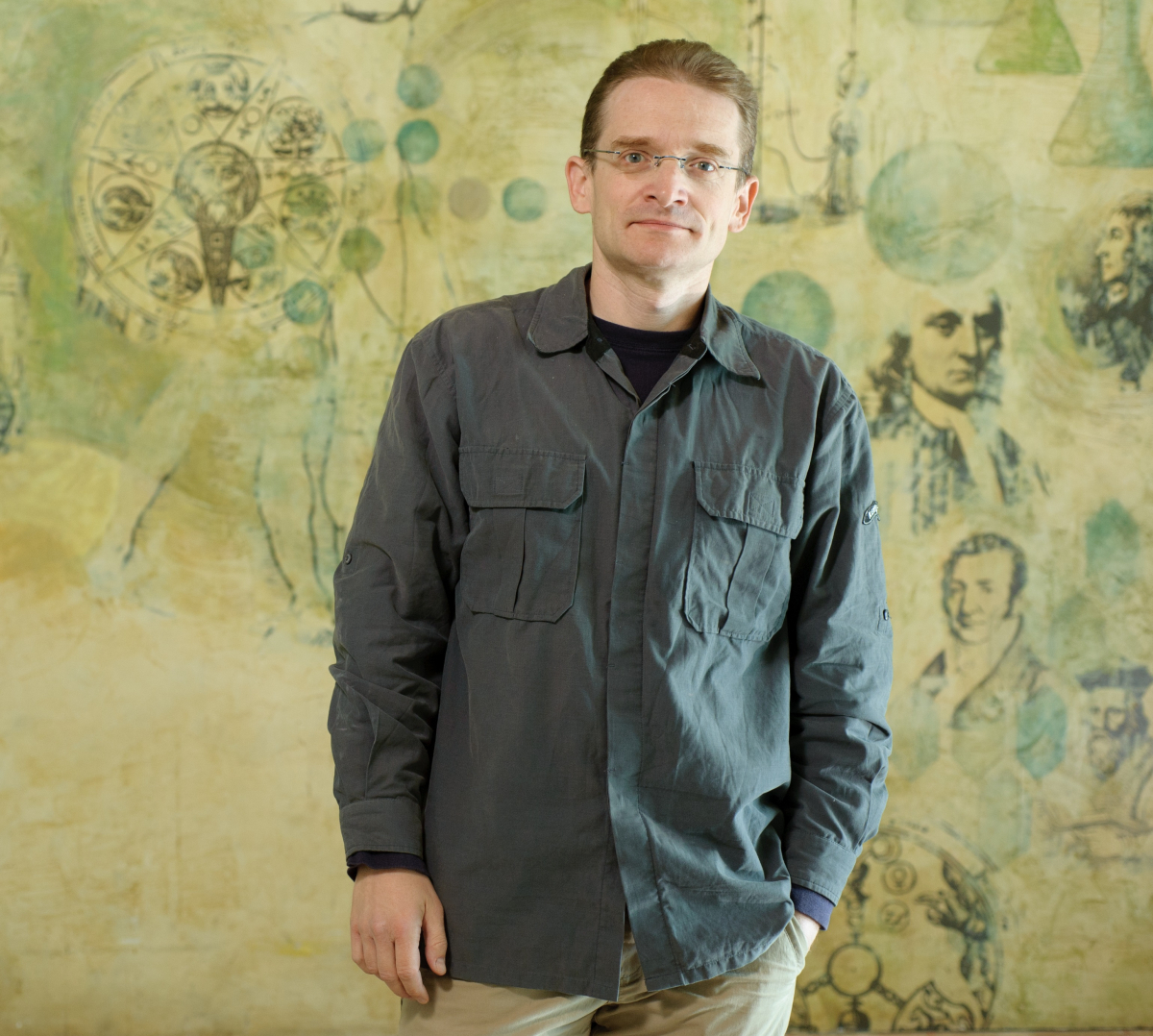
Like all scientists, Prof. Boris Rybtchinski is very curious by nature. From an early age, he took things apart down to their smallest components to understand how they work. He contemplated studying philosophy or literature as way of deconstructing life to better understand it, but ultimately it was the mystery of molecules that pulled him towards studying chemistry.
It began with crystals. He was fascinated by their chemical formations and how what starts as an essentially chaotic mess of molecules can turn into the epitome of order and symmetry. Crystals form the base of materials all around us—computer chips, solar cells, concrete, and pharmaceuticals to name a few—are all made from these complex structures. Understanding the mechanisms behind their formation can help scientists create robust, adaptive, and sustainable materials with all the functionality and fewer drawbacks. Thanks to his love for taking things apart, Prof. Rybtchinski can create simple nanomaterials which can be assembled and disassembled, like building blocks, to form or deconstruct new materials.
He is now focusing his research and expertise on protecting the planet and creating a more sustainable future.
“As scientists, if we know how things work and how to control processes to make a new material which addresses a societal problem, then it is our duty to do so,” he says. “I know how things assemble, and this knowledge is quite powerful. And I believe that we have to act now, because we have no time.”
Prof. Rybtchinski has zeroed in on a ubiquitous problem: plastics—the non-biodegradable material that can be found in everything from the water we drink and the air we breathe, to the Texas-sized island of garbage floating in the Pacific Ocean. His solution: developing a method to grow tiny mechanically strong organic crystalline fibers within biodegradable polymers to form durable, eco-friendly plastics.
Assisted by Bina, Weizmann’s idea incubator, Yeda R&D, the Institute’s tech-transfer arm, and SAERI grants, Prof. Rybtchinski and his team are working to make their new bioplastics industrially viable and scalable.
The history of sustainability research at the Weizmann Institute
In the early 1970s, during his tenure as President of the Weizmann Institute, the late Prof. Israel Dostrovsky understood that Israel’s dependence on oil would lead to an energy crisis and that it was time the Institute harness its research prowess to find energy alternatives. A chemist by training, he also understood the detrimental effects of burning fossil fuel on the environment.
“The need to develop alternative sources of energy to replace oil, gas, and coal has never been more pressing. But from the moment an idea for a new process or technology is hatched in the laboratory, it takes decades until it can be implemented commercially on a large scale,” he later wrote. “This means that if we are to avert a global crisis in the next century, we must begin to develop and test alternative energy sources now.”
With this mission in mind, in the early 1980s, Prof. Dostrovsky established the Center for Energy Research to support studies on solar energy as a viable alternative to carbon-heavy fossil fuels.
By the late 1980s, alternative energy research at Weizmann gathered enough momentum that a group of Canadian donors, led by the late Tom and Mary Beck, established the Canadian Institute for the Energies and Applied Research (CIEAR), a 3,000-kilowatt experimental solar power facility with a 54-meter tower. The facility also included a field of 64 mirrors that tracked the movement of the sun and collected sunlight for experiments. One of the most sophisticated facilities in the world at the time, CIEAR united basic science with industrial needs to design methods of exploiting concentrated solar energy.
In 1995, a collaboration between the Weizmann Institute, American aerospace manufacturer McDonnell Douglas, and Israeli tech companies Ormat Industries and Rotem Industries received an $8 million grant from the US-Israel Science and Technology Commission to develop a model for a cost-efficient solar thermal energy plant. The Institute was charged with creating the tools needed to concentrate and convert the sun beams into useful energy and demonstrate the commercial feasibility of the solar power plant model. The findings were later adapted for commercialization by the tech sector.
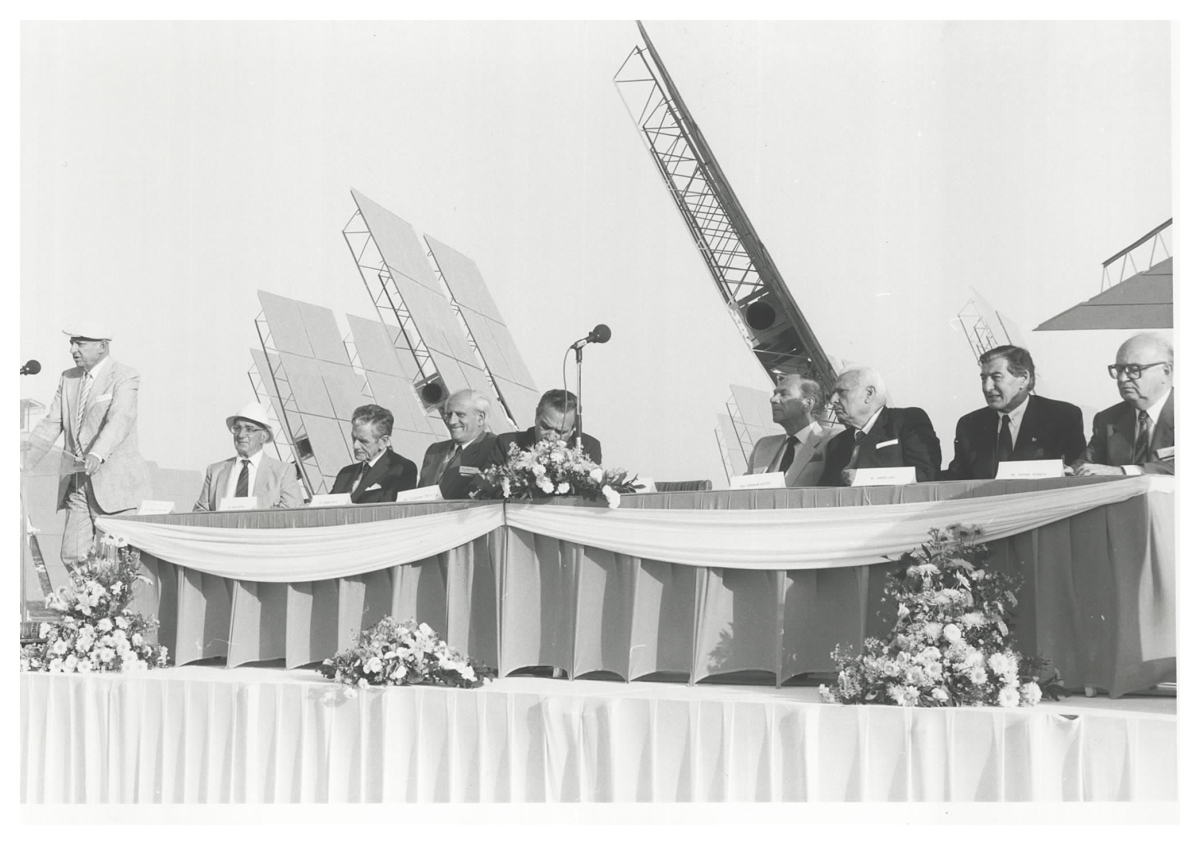
Inauguration of the Canadian Institute for the Energies and Applied Research, 1988. Speaker: Prof. Aryeh Dvoretzky, From left: Prof. Israel Dostrovsky, Hans Merkle, Tom Beck, Gideon Patt, Murray Koffler, Prof. Ephraim Katzir, James Kaye, and Adv. Moshe Porat.
Serendipity in the air
In 2005, Prof. Mordechai (Mudi) Sheves, the Dean of the Faculty of Chemistry, observed that scientists from various fields—chemistry, biology, and physics to name a few—were interested in topics related to alternative energy research. Through a series of serendipitous events, he connected with Israeli entrepreneur and philanthropist Yossie Hollander and together they founded the Alternative Energy Research Initiative (AERI) in 2006.
“It all comes down to alternative energy and the technologies needed to develop a new energy economy,” Hollander recalls. “I knew that Weizmann had the ability to push the limits of scientific discovery to develop breakthrough ideas for these essential technologies.”
In 2008, the Beck family established the Mary and Tom Beck Canadian Center for Alternative Energy Research, as part of AERI. Reflecting on her family’s investment, Tom and Mary’s daughter, Cathy Beck, says, “Success in the field of sustainability research helps everyone, across the world. Energy and advanced materials research are central to that mission. My parents wanted Weizmann scientists to have every chance and resource to see where their curiosity takes them, because the things they find will benefit us all today, and far into the future.”
AERI’s first task was to help scientists understand that their work was connected to the greater cause of protecting the planet and its natural resources.
“We tried to interest as many scientists as possible, finding ways that their expertise could be relevant to alternative energy research, ultimately spreading it across almost all faculties on campus,” recalls Prof. Emeritus David Cahen, founding director of AERI.
They launched an internal grant program through which scientists could apply for seed funding for “blue-sky” and speculative, basic research not generally funded by conventional sources.
Prof. Ronny Neumann in the Department of Molecular Chemistry and Materials Science, for example, used AERI funding to develop a process by which CO2 captured from the atmosphere can be used to make valuable carbon-based products. His discoveries led to external funding, new patents, and the formation of a startup for the large-scale production of environmentally friendly products, such as synthetic fuel, plastics, and cleaning detergents.
“The AERI program shifted my interests and led to new areas of study, with overall goals of sustainability, specifically towards a zero-carbon society,” Prof. Neumann recalls. “These novel and fruitful research directions will hopefully lead to more commercially viable companies in the future.”
The Institute’s focus on environmental science and protection widened into what would be known as the SAERI program, positioning it as a world leader in solar energy and sustainability research.
Fellows of the future
When he took over as SAERI director, Prof. Milo initiated a fellowship program to support the future leaders of the field—the brightest PhD students who have a passion for sustainability research.
Research at the Weizmann Institute supported by this framework led to breakthroughs in everything from solar cell materials that are the basis for the solar to electrical energy conversion technology used today, to the ability to recycle high-energy-density magnets used in wind turbines and electric vehicles without toxic byproducts. What was once the vision of a small group of forward-thinking scientists, supported by similarly-minded donors, has blossomed into a multimillion-dollar flagship—the Institute for Environmental Sustainability—to inspire the breakthroughs needed for game-changing sustainable technologies.








